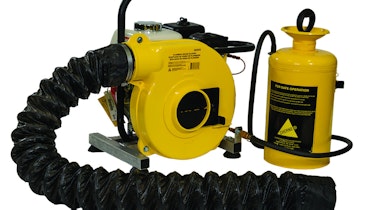
In Fort Wayne, Indiana, the working site for a massive tunnel-boring project is currently being prepared. Work on the tunnel, expected to help reduce CSOs by 90 percent, is scheduled to begin in summer 2018.
Interested in Stormwater?
Get Stormwater articles, news and videos right in your inbox! Sign up now.
Stormwater + Get AlertsThe EPA recently recognized 28 different wastewater, septic system and stormwater projects for being innovative in their design or financing.
Projects funded by the federal low-interest loan program, the Clean Water State Revolving Fund, were eligible for recognition. Each participating state program nominated one project. Out of the 28 projects recognized by the EPA, five of them earned “exceptional” honors and five others received honorable mention.
MSWmag.com has taken a closer look at two of the “exceptional” projects:
Utility Funnels Federal Funds to Customers’ Sewer Lateral Replacements
Utility Saves Big on CSO Project Financing
As well as two of the projects receiving honorable mention:
Converting Storm Sewer to Creek Helps City Fight Chronic Flooding
Park Projects Create 1.2 Million Gallons of Stormwater Storage for City
Here’s a look at a few more of the State Revolving Fund financed projects recognized by the EPA.
Fort Wayne, Indiana
Fort Wayne, Indiana, broke ground on the largest public works project in city history earlier this year. And it made the EPA’s list of 28 recognized projects due to it being aided by a $188 million Clean Water State Revolving Fund loan.
The project is a 5-mile-long, 16-foot tunnel with another mile of 18-foot connection sewers that can accommodate 800 million gpd of flow. Stemming from a 2008 consent decree to reduce CSOs, the project is a major component of that effort — when fully completed and put into operation in 2023 it is expected to reduce CSOs by 90 percent. The working shaft for the tunnel-boring machine is currently being dug and construction on the tunnel will begin in summer of 2018.
“We know that in four to six years, we will see a 90 percent reduction in the amount of combined sewer overflow going into our rivers — a reduction of more than 850 billion gallons on average each year,” Matthew Wirtz, deputy director of city utilities, said at the groundbreaking in June. “That will benefit the entire community and our waterways as well as those downstream all the way to Lake Erie. We also know that in the next four to six years, we will see a reduction in neighborhood street flooding and basement backups. The tunnel will directly help 30 neighborhoods, 15,000 properties and around 45,000 residents.”
Hinesville, Georgia
The city of Hinesville, Georgia, has been able to reduce the amount of total suspended solids deposited in Peacock Creek and other local water bodies by 80 percent. That’s largely thanks to a 15-acre man-made lake in Bryant Commons, a large public park near downtown that has gradually been developed in recent years.
The city designed the lake to retain and treat the stormwater coming from downtown instead of it immediately going into area waterways. Discharges from the lake are made through a series of cascades, oxygenating the water and allowing for better aquatic life in creeks and rivers. A $4 million Clean Water State Revolving Fund loan aided the project.

A 15-acre man-made lake in a park in Hinesville, Georgia, handles the stormwater that comes from downtown.
Queen Anne’s County, Maryland
Queen Anne’s County, Maryland, is working to connect 1,526 properties on South Kent Island to a sewer system. The properties being targeted are in nine different communities that have been plagued by failing septic systems, thus posing a risk to the water quality of Chesapeake Bay.
The project, on schedule to be completed in 2025, is currently in its first phase — connecting 774 homes in Kent Island Estates and Romancoke. The move from septic to sewer service will reduce the amount of nitrogen going into Chesapeake Bay annually by 7,000 pounds. Queen Anne’s County is trying to complete the $55 million project while still keeping it affordable for customers. A majority of the funding — $34 million — is coming through a Clean Water State Revolving Fund loan that includes $1.2 million in loan forgiveness, a 0.8 percent interest rate, and a 30-year repayment term.
“The EPA recognition validates the creativity and joint effort on this long road taken for a project that is the absolute right thing to do,” Queen Anne’s County Commissioner Mark Anderson told The Kent Island Bay Times.

Queen Anne's County, Maryland, is in the middle of a 10-year project to convert 1,526 properties on South Kent Island from septic to sewer.





